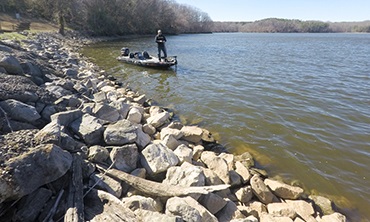 Cranking riprap is highly effective early in the year, when sunbaked rocks warm the water just a bit and bass use those rocks as ambush points for feeding. You likely know that already. But how do you get the most out of your cranking efforts? These tips can help you pull more fish off the rocks.
Cranking riprap is highly effective early in the year, when sunbaked rocks warm the water just a bit and bass use those rocks as ambush points for feeding. You likely know that already. But how do you get the most out of your cranking efforts? These tips can help you pull more fish off the rocks.
Get Bold
Riprap bass are in ambush mode, and they won’t follow anything far or study a slow-moving offering. In addition, the water tends to be higher and more stained than usual in many lakes this time of year. Use bright-colored crankbaits with plenty of red or orange to suggest crawfish or chartreuse if shad are the main attraction.
Fatten Up
Wide-bodied and wide swinging crankbaits that defect rocks and wood cover well and offer a bit of extra buoyancy for rolling over rocks or backing out of tight places definitely work best for this approach. Good options include a Bomber Fat A and Norman Middle N or a big-bodied squarebill, such as the new Bandit Rack-It.
Tighten Up
Keep your boat close to the edge and cast parallel or roughly parallel. That keeps your lure near the rocks and in the strike zone the entire presentation. Just be aware that a bass might attack one crank into a retrieve or 6 inches from the tip of your rod.
Consider Current
Any bank that gets swept by current or forms and eddy just out of a noteworthy current will be more productive than one that has no flow beside it. River current is the most predictable and affects every level of the water column, but if the wind is really sweeping a bank, wind current can be a major player.
Keep on the Sunny Side
Watch for where the sun hits the rocks, whether due to a southern exposure or a simple lack of shade. Focus on banks that get baked by sun, especially in the afternoon on a bright day.
Bang, Bang, Bang
It’s true for virtually all crankbait fishing, but extra true for cranking riprap: The more rocks and other stuff you can hit with your lure, the better. Pick lures that will reach the rocks, use fluorocarbon if needed, cast tight to cover and keep your rod low. Don’t worry about snags. You can usually get lures back at this depth. If you’re not getting snagged at all, you’re almost certainly not keeping your lure where it needs to be.
Identify Oddities
At a glance, a riprap bank can look very uniform, but that’s seldom the case, and finding oddities can be the key to finding fish. Watch constantly for anything different, and hit those spots with strategic presentations. Slight points or cuts, Oversized rocks, pipes, isolated wood cover, floating debris… anything that creates a unique ambush point is apt to hold fish.
Change Directions
Bass commonly position themselves a certain angles, relative to cover, making presentations from one direction excellent for to prompting ambush strikes while rendering presentations from opposite direction useless because fish don’t see the lure at all or they see it for too long and get spooked. Sometimes strong wind or current only allows you to work one way. When possible, though, work a stretch of bank in one direction and then turn it around and fish it from the opposite direction.
Repeat
When you catch a fish, repeat that exact cast a few times. Often another fish will be set up just like the one you just caught. Also, make mental notes about the specific spots where you catch fish or miss strikes. If they hold fish once, they’ll often hold fish again.
Return
Finally, don’t hesitate to hit a bank that should produce well several times during a day. For a host of reasons, riprap bank bites turn on and off like someone is messing with a switch. Even if you don’t get a sniff along a stretch of bank, if everything looks right, be sure to return late in the day. You might be amazed by what happens on the second pass.
Relate articles

